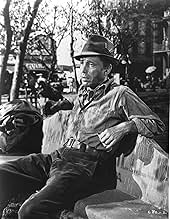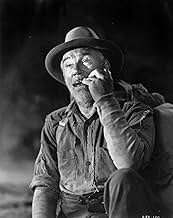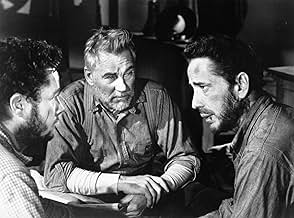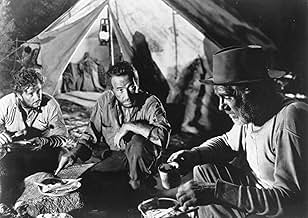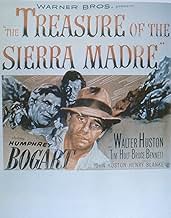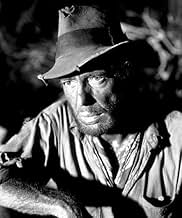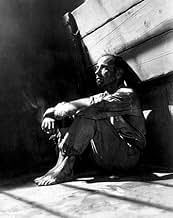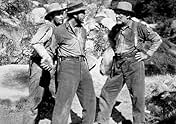IMDb RATING
8.2/10
137K
YOUR RATING
Two down-on-their-luck Americans searching for work in 1920s Mexico convince an old prospector to help them mine for gold in the Sierra Madre Mountains.Two down-on-their-luck Americans searching for work in 1920s Mexico convince an old prospector to help them mine for gold in the Sierra Madre Mountains.Two down-on-their-luck Americans searching for work in 1920s Mexico convince an old prospector to help them mine for gold in the Sierra Madre Mountains.
- Won 3 Oscars
- 18 wins & 5 nominations total
Barton MacLane
- Pat McCormick
- (as Barton Mac Lane)
Arturo Soto Rangel
- Presidente
- (as A. Soto Rangel)
Manuel Dondé
- El Jefe
- (as Manuel Donde)
José Torvay
- Pablo
- (as Jose Torvay)
Robert Blake
- Mexican Boy Selling Lottery Tickets
- (uncredited)
Guillermo Calles
- Mexican Storeowner
- (uncredited)
Roberto Cañedo
- Mexican Lieutenant
- (uncredited)
Spencer Chan
- Proprietor
- (uncredited)
Jacqueline Dalya
- Flashy Girl
- (uncredited)
Ralph Dunn
- Flophouse Bum
- (uncredited)
Ernesto Escoto
- Mexican Bandit
- (uncredited)
- Director
- Writers
- All cast & crew
- Production, box office & more at IMDbPro
Summary
Reviewers say 'The Treasure of the Sierra Madre' is a critically acclaimed classic, lauded for its profound examination of greed, betrayal, and human nature. John Huston's direction and screenplay, alongside exceptional performances by Humphrey Bogart, Walter Huston, and Tim Holt, are often celebrated. The film's authentic atmosphere, intricate character studies, and moral complexities deeply resonate. Although some critique its pacing and subplots, most regard it as a timeless masterpiece noted for its psychological depth and thematic richness.
Featured reviews
Film noir takes a Mexican holiday in this gritty adventure from John Huston. Pessimistic and full of irony, yet with a sense of adventure and a moralist edge to it, this is typical Huston material.
Huston insisted on shooting on location in Mexico, which riled up studio executives no end, but it paid off in the quality of the picture. Treasure of the Sierra Madre would have really suffered in the canned air of a studio. By using the real thing, he perfectly achieves the stark and dusty atmosphere of the poverty riddled Mexican city in the earliest scenes. The sense of scale and grandeur of the mountains in the main part of the film is also very important in achieving the right effect.
Huston's background was in fine art, and it's at this point in his career as a director that it really starts to show. The use of lighting is painterly in a way that is almost impossible to achieve in black and white particularly in the scene in the peasant village which looks almost biblical. Huston also has this unique style of framing, whereby he uses figures in the foreground and background to give the effect of a close-up and a mid-shot simultaneously. It's a look that is totally at odds with anything else produced in Hollywood at that time.
Actor wise, Treasure of the Sierra Madre turns the clock back to the 1930s, putting the director's father Walter Huston in a starring role, and casting Humphrey Bogart as a seedy villain. The cast is rounded off by the too-little-seen Tim Holt. All three of them are spot on. The spry old prospector is a role Huston senior seems to have been waiting to play all his life. Bogart is also great playing the sort of character he made his name with a decade earlier. Also worth a mention is Mexican actor Alfonso Bedoya who gives what is for this era an incredibly naturalistic performance as the bandit leader.
Huston's forte was in his cinematography, his shot composition and the rhythm of his films, not so much in his handling of action or actors, which is why his pictures tend to be a bit hit and miss. This one is a hit though, thanks to the strength of its story and the quality of the cast, not to mention Huston's persistence for authenticity. Not my absolute favourite of his work, but certainly one of the best.
Huston insisted on shooting on location in Mexico, which riled up studio executives no end, but it paid off in the quality of the picture. Treasure of the Sierra Madre would have really suffered in the canned air of a studio. By using the real thing, he perfectly achieves the stark and dusty atmosphere of the poverty riddled Mexican city in the earliest scenes. The sense of scale and grandeur of the mountains in the main part of the film is also very important in achieving the right effect.
Huston's background was in fine art, and it's at this point in his career as a director that it really starts to show. The use of lighting is painterly in a way that is almost impossible to achieve in black and white particularly in the scene in the peasant village which looks almost biblical. Huston also has this unique style of framing, whereby he uses figures in the foreground and background to give the effect of a close-up and a mid-shot simultaneously. It's a look that is totally at odds with anything else produced in Hollywood at that time.
Actor wise, Treasure of the Sierra Madre turns the clock back to the 1930s, putting the director's father Walter Huston in a starring role, and casting Humphrey Bogart as a seedy villain. The cast is rounded off by the too-little-seen Tim Holt. All three of them are spot on. The spry old prospector is a role Huston senior seems to have been waiting to play all his life. Bogart is also great playing the sort of character he made his name with a decade earlier. Also worth a mention is Mexican actor Alfonso Bedoya who gives what is for this era an incredibly naturalistic performance as the bandit leader.
Huston's forte was in his cinematography, his shot composition and the rhythm of his films, not so much in his handling of action or actors, which is why his pictures tend to be a bit hit and miss. This one is a hit though, thanks to the strength of its story and the quality of the cast, not to mention Huston's persistence for authenticity. Not my absolute favourite of his work, but certainly one of the best.
Some movies have certain scenes in them that hold the viewers interest more than others. However every single scene in this film holds the viewers interest. There is never a dull or lagging moment. Three down and outers who at one time in their lives were maybe up and comers strike out in search of a fortune or at least enough to live better than they have been.
While Humphrey Bogart gives a superb performance it is Walter Huston who turns in the greatest performance as the old prospector Howard. The scene in the Indian village where he helps to restore a comatose child is one of the most touching in all of film history and is done virtually without any dialog. Mexican character actor Alfonso Bedoya of course steals all the scenes he appears in and delivers his classic "Stinking Badges" line. (what person would dress up as a Bandito for a costume party and not want to look exactly like Bedoya's Gold Hat character?) This film probably should have been a little higher on AFI's top 100. A must see!
While Humphrey Bogart gives a superb performance it is Walter Huston who turns in the greatest performance as the old prospector Howard. The scene in the Indian village where he helps to restore a comatose child is one of the most touching in all of film history and is done virtually without any dialog. Mexican character actor Alfonso Bedoya of course steals all the scenes he appears in and delivers his classic "Stinking Badges" line. (what person would dress up as a Bandito for a costume party and not want to look exactly like Bedoya's Gold Hat character?) This film probably should have been a little higher on AFI's top 100. A must see!
Two penniless Americans (Humphrey Bogart and Tim Holt) during the 1920s in Mexico join with an old-timer (Walter Huston, the director's father) to prospect for gold. The old-timer accurately predicts trouble, but is willing to go anyway. The film is fictional, but presents a very realistic scenario: By the 1920s the violence of the Mexican Revolution had largely subsided, although scattered gangs of bandits continued to terrorize the countryside. The newly established post-revolution government relied on the effective, but ruthless, Federal Police, commonly known as the Federales, to patrol remote areas and dispose of the bandits. Foreigners, like the three American prospectors, were at very real risk of being killed by the bandits if their paths crossed. The bandits, likewise, were given little more than a "last cigarette" by the army units after capture, even having to dig their own graves first.
The film shows the Americans doing just about anything for money: drilling oil, digging for gold, begging and more. And once gold comes into the picture, the men who once claimed they were not greedy see things differently. Bogart actually goes mad, after he gets greedy and paranoid... during which he encounters a gila monster! The most memorable scene of this film involves the bandits, who don't need any "stinking badges". While the line is much more quotable in "Blazing Saddles", we couldn't have "Blazing Saddles" (or "UHF") without this film... just about everyone, even those who never saw or heard of "Sierra Madre", knows the badges line.
Humphrey Bogart's best film is probably "Casablanca", but this one features him in a nice, rough exterior. Yes, sometimes leading men have beards and are covered in dirt. Pretty boys do not stay pretty boys after digging in the hills, or at least that wouldn't be realistic. This film does a fine job trying to "keep it real", so we have to commend Huston not only on his directing, but his wonderful location scouting.
The film shows the Americans doing just about anything for money: drilling oil, digging for gold, begging and more. And once gold comes into the picture, the men who once claimed they were not greedy see things differently. Bogart actually goes mad, after he gets greedy and paranoid... during which he encounters a gila monster! The most memorable scene of this film involves the bandits, who don't need any "stinking badges". While the line is much more quotable in "Blazing Saddles", we couldn't have "Blazing Saddles" (or "UHF") without this film... just about everyone, even those who never saw or heard of "Sierra Madre", knows the badges line.
Humphrey Bogart's best film is probably "Casablanca", but this one features him in a nice, rough exterior. Yes, sometimes leading men have beards and are covered in dirt. Pretty boys do not stay pretty boys after digging in the hills, or at least that wouldn't be realistic. This film does a fine job trying to "keep it real", so we have to commend Huston not only on his directing, but his wonderful location scouting.
Tampico sets the scene for the start of speculation, Fred C. Dobbs is out of cash and his luck is in cessation, but an encounter in flophouse, and big dreams emerge and arouse, as a plan is born with Howard, and a fellow who's called Curtin. Into hills laden with gold, our companions then embark, finding seams that come alive with golden riches to impart, building up substantial fortune, thinking soon they will be tycoons, but there's one who's trust is waning and has sores that start to smart. The journey back becomes a challenge to them all, as one by one the group is scattered, battered, stalled, will their work be well rewarded, will endeavours all be thwarted, either way, you will be engaged, and quite possibly enthralled.
Bogarts best performance.
Bogarts best performance.
This film made a huge impression on me when I first saw it at the age of 15 or 16. A recent rewatching on DVD really served to bring home for me what makes this film so special.
The whole thing is quite good, but it really hits you when Howard goes off to celebrate with the Indians, leaving Dobbs and Curtin to care for his gold and burros. The ensuing scenes of their spiraling mistrust and tension are absolutely spellbinding--the kind of thing that makes you lean forward in your seat just to get your eyes a little closer to the raw humanity unfolding in front of you. Their paranoia, the way you can SEE scenarios of betrayal dancing in their eyes, Dobbs' burgeoning madness--these are the moments that make this film one for the ages.
At its best, film noir (which this most certainly is--Western surroundings or no) makes the viewer complicit in the evil depicted on screen. We find ourselves scheming and plotting in our heads along with the unsavory characters we are watching--we start to feel the same temptations and desires that they do. "Treasure of the Sierra Madre" accomplishes this bond with the audience as well as any film you are likely to see.
A magnificent film--one of the few great screen tragedies.
The whole thing is quite good, but it really hits you when Howard goes off to celebrate with the Indians, leaving Dobbs and Curtin to care for his gold and burros. The ensuing scenes of their spiraling mistrust and tension are absolutely spellbinding--the kind of thing that makes you lean forward in your seat just to get your eyes a little closer to the raw humanity unfolding in front of you. Their paranoia, the way you can SEE scenarios of betrayal dancing in their eyes, Dobbs' burgeoning madness--these are the moments that make this film one for the ages.
At its best, film noir (which this most certainly is--Western surroundings or no) makes the viewer complicit in the evil depicted on screen. We find ourselves scheming and plotting in our heads along with the unsavory characters we are watching--we start to feel the same temptations and desires that they do. "Treasure of the Sierra Madre" accomplishes this bond with the audience as well as any film you are likely to see.
A magnificent film--one of the few great screen tragedies.
Storyline
Did you know
- TriviaJohn Huston stated that working with his father on this picture and his dad's subsequent Oscar win were among the favorite moments of his life.
- GoofsAlthough set in the 1920s, many of the cars on the streets of Tampico are of 1930s and 1940s vintage; likewise, women, when prominently seen, are groomed and dressed strictly in the style of the 1940s.
- ConnectionsFeatured in The Screen Writer (1950)
- SoundtracksBelieve Me If All Those Endearing Young Charms
(1808) (uncredited)
Music traditional
Played on harmonica by Walter Huston
Details
- Release date
- Country of origin
- Languages
- Also known as
- El tesoro de la Sierra Madre
- Filming locations
- Kernville, California, USA(Kelly's Rainbow Mine)
- Production company
- See more company credits at IMDbPro
Box office
- Budget
- $3,000,000 (estimated)
- Gross US & Canada
- $5,014,000
- Opening weekend US & Canada
- $144,074
- Jan 14, 2018
- Gross worldwide
- $5,014,000
- Runtime2 hours 6 minutes
- Color
- Aspect ratio
- 1.37 : 1
Contribute to this page
Suggest an edit or add missing content

Top Gap
What was the official certification given to The Treasure of the Sierra Madre (1948) in Japan?
Answer

